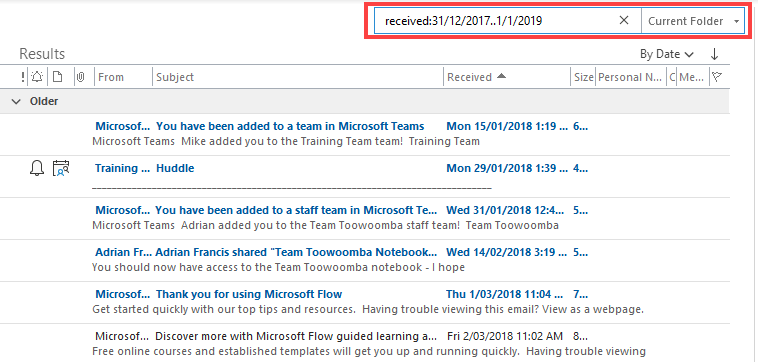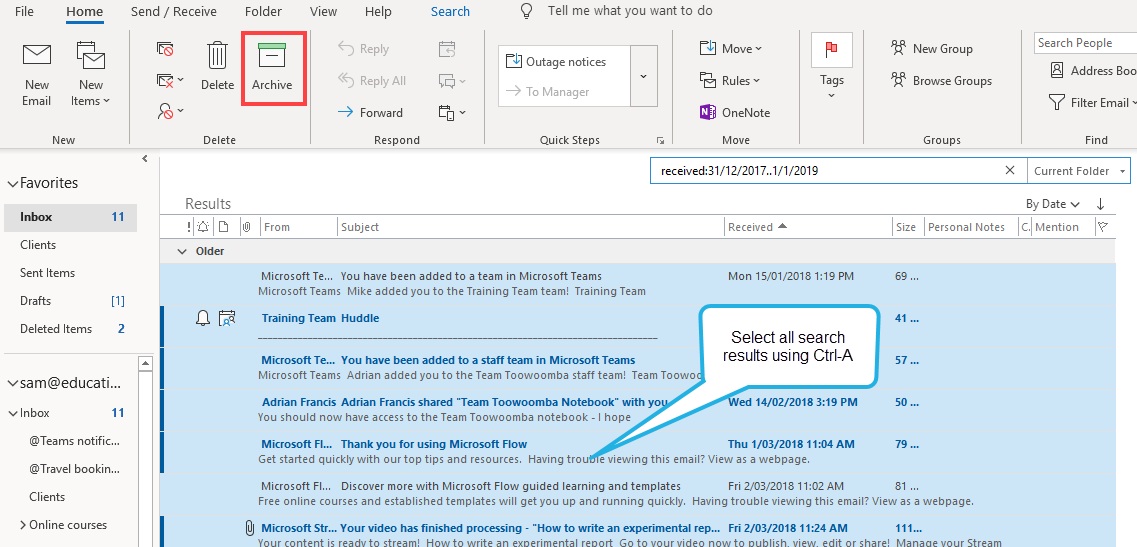Spring has sprung here in the Southern Hemisphere, and we’re continuing our series of posts on doing an Inbox spring clean. In this second post, I’ll show you how to spring clean your inbox in Outlook for Windows (if you’re a Gmail user, check out this post).
Note: The steps and images shown in this post are for Outlook for Office 365 (Windows desktop version 1908, October 2019). Some things may look a little different if you are using another version of Outlook, but the general process will remain the same.
Why you should spring clean your Inbox
Let me start by saying that not everyone needs to spring clean their inbox. If you’ve got your emails under control with an effective processing and tracking system in place, you’ll probably have only a small number of emails sitting in your inbox at any one time. However, the majority of people I meet haven’t achieved this state of inbox control yet! If you’ve got hundreds, or thousands, or maybe even tens of thousands of emails in your inbox, it’s time for an Inbox spring clean! Why? Because opening your inbox every day to a huge email count is very likely causing you some level of frustration, anxiety and cognitive overload (even if you don’t realise it). Imagine what it would be like to open your Outlook mail and see all your mail with minimal scrolling…that’s what an Inbox spring clean can help you do.
An Inbox spring clean is also the first step in implementing new efficiency-boosting email management practices. You need to clear the email backlog first, then you can put new systems in place. If you’re keen to learn more about efficiency-boosting email management practices, check out our posts on How to organise your folders in Microsoft Outlook and How to quickly find an email in Microsoft Outlook.
[bctt tweet=”Does your #Outlook Inbox need a spring clean?” username=”samvardanega”]
How to do an Inbox spring clean
To perform a spring clean in the Outlook inbox, you will need to use the advanced search tool and the Archive button (click on the links if you want to learn more about these features).
Follow these steps to start cleaning!
1. Find out what the oldest email in your inbox is by clicking on the Received column heading to sort mail by date. You may need to click it twice to sort oldest-to-newest (which is the little arrow pointing up). Scroll up to the top of the inbox and check the date on the oldest email. Warning, you may get a shock!

2. Decide how you want to spring clean. For example, on a year-by-year basis or everything at once. I strongly recommend year-by-year if you have more than a few thousand emails in your inbox. You may even need to use smaller date ranges if you have a large backlog of mail. (I have found the process can time out and fail if you try and archive too many at once).
3. Based on your decision in step 2, use the search box to perform an advanced search for emails in your inbox, based on a particular date range (starting with whatever year your oldest email is from). To do this:
- Click into your Inbox, then choose Current folder from the drop down box on the right of the search box. This will limit the search only to your inbox (you don’t want to archive everything in your mail account!).

- Enter the text received:start date..end date into the search box. For example, to capture all emails from 2018, I would use the search text received:31/12/2017..1/1/2019.
- After you have done the search, check at the bottom of the search results for a message that says there are more search results on the server, or that it is only showing recent results. You may need to click ‘See all’ or ‘See more’ to see all the emails from that date period.

4. Press Ctrl-A on your keyboard to select all of the emails in the search results.
5. Press the Archive button on the Home tab.
Note: If you have never archived an email before, you may be prompted to create an Archive folder at this point.

6. The archiving will now begin. The archiving process can take a while and Outlook may display a ‘Not responding’ message while it is archiving. Just be patient and wait for it to complete!
7. Repeat steps 3-5 for all other years in your inbox. The easiest way to do this is to adjust the year dates in the existing search criteria.
All the emails will now be located in the Archive folder for the email account. You can easily find these emails using the search feature. Check out this blog post if you need some tips on searching effectively.
Want even more tips for getting your Inbox under control? Contact us to learn more about our email efficiency workshops for Microsoft Outlook.











